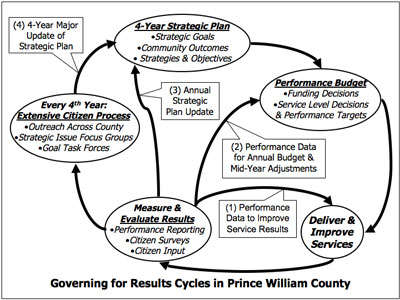Citizens Help Build the Plan, and Stay Engaged Throughout Results-based Governance
Prince William County, Virginia, uses systematic results-based governance in which citizens are engaged throughout to ensure the results sought and achieved are those people most care about. The county uses its strategic plan as the foundation for results-based governance as the plan drives the budget, which in turn drives performance measures and targets. Every four years, that plan goes through a major update process with extensive citizen engagement. Citizens’ influence on the strategic plan flows through to millions of dollars in budget shifts and service delivery targets that match the priorities citizens identified and the elected Board of Supervisors reviewed and approved. The county’s multi-faceted performance feedback cycles, which give citizens additional ways to be involved, helps assure planned service levels are attained, improvements are made as needed, and accountability for results desired by citizens is achieved.
How Prince William County Governs for Results
Prince William County’s citizens influence what gets planned, measured, and fed back into decision making. Major strategic planning updates every four years engage citizens through phone surveys about their priorities and focus groups held throughout the county that engage hundreds of citizens deliberatively to develop a focused set of priority issues. Then, a newly elected Board of Supervisors appoints citizen goal task forces to develop major strategic goals and recommended measurable outcomes for goals, which the Board considers, modifies through its own deliberation, and adopts as the County Strategic Plan. The board also conducts annual progress reviews against the strategic plan, in which citizens participate, which can lead to plan revisions. The results-based cycles are completed through regular feedback of performance information to help program managers, executive staff, and the Board make changes to improve day-to-day service delivery, including midyear budget adjustments as needed. Annual citizen satisfaction surveys also influence service and budget adjustments.
Citizen Roles in Community Improvement
Consistent with Advanced Practice 4, Prince William County citizens are engaged in many roles throughout the governance process from the earliest planning stages. For example, citizens are engaged as issue framers (foundation builders and agenda setters) in the county strategic planning process through surveys, focus groups, and goal task forces. Some citizens are also collaborators with county staff as co-facilitators of the focus groups. In the goal task forces, and in other deliberative processes such as comprehensive land use and facilities planning, citizens collaborate to forge compromises that work for different interests. Citizens are also engaged every spring as stakeholders through surveys on the quality of life and satisfaction with county services. They are also evaluators of the performance information that county staff provides to citizen task forces and advisory committees. Some citizens also come to the Board of Supervisors and various committees as advocates for different interests, and have presented outcome data that has influenced Board decision. The county executive’s office has a citizen participation coordinator who helps citizens find volunteer roles in which citizens often act as coproducers to augment government services. As the county has gained trust by creating many opportunities for engagement and citizens have learned that their efforts make a difference, citizens have become continually engaged in many ways throughout the entire process to help their community achieve results that matter.
Additional Community Improvement Themes
Consistent with Advanced Practice 4, in addition to robust citizen engagement, Prince William County uses performance feedback, collaborations, and results linked to resources and accountability to govern for results. The county’s results-based governance system is driven by the strategic plan, and has several systemic performance feedback cycles that drive change to improve measured results between major strategic plan updates (see Figure).

In addition to using performance feedback for frequent monitoring, adjustment, and improvement of services, the Board of Supervisors has listened when presented with performance data showing a need for major change. For example, in 1996 citizen advocates presented data on deteriorating social conditions such as homelessness and substance abuse, prompting the Board to add a “human services” strategic goal midway through a four-year strategic planning cycle. The county’s discipline in aligning its budget with strategic plan goals ensures there are resources linked to desired results. County departments and service contractors are held accountable for achieving results through measurable performance targets and performance reports reviewed by county management and the Board. The county’s annual public performance report adds another level of performance accountability to citizens. Prince William County also makes extensive use of collaborations with other governments, nonprofits, businesses, and citizens to line up many organizations behind common county goals and make creative use of citizens as community assets. An unusually strong collaboration between the county government and the local school board, for example, led to schools being built and renovated ahead of schedule to stay ahead of regional population growth. That collaboration shows respect for engaged citizens who identified education as a high priority goal in county strategic planning. Rather than tell citizens education is not a county government responsibility, the county has worked closely with the school board to adopt and support goals of improving the school system and advancing student achievement.
- See a full List of Examples and Case Studies in Results That Matter
- Go to the Overview of Effective Community Governance or read Chapter 1 of Results That Matter for more on the advanced governance practices of the Effective Community Governance Model and related key community improvement themes.

